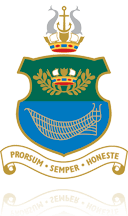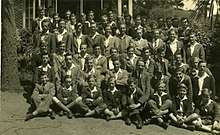Devonport High School for Boys
Devonport High School for Boys is a grammar school and academy, for boys aged 11 to 18, in Plymouth, Devon, England. It has around 1,135 pupils. Its catchment area includes southwest Devon and southeast Cornwall as well as Plymouth. Pupils are accepted on the basis of academic aptitude.
| Devonport High School for Boys | |
|---|---|
 | |
| Address | |
Paradise Road Devonport, Plymouth , , PL1 5QP England | |
| Coordinates | 50.374071°N 4.162273°W |
| Information | |
| Type | Grammar school Academy |
| Motto | Prorsum Semper Honeste — Forward always honest/proud |
| Established | 1896 |
| Founder | Alonzo Rider |
| Department for Education URN | 136496 Tables |
| Ofsted | Reports |
| Head teacher | Dan Roberts |
| Staff | over 100 |
| Gender | Boys (Mixed sixth form) |
| Age | 11 to 18 |
| Enrolment | 1,135 |
| Houses | Campbell Edison Newton Priestley Smeaton Winstanley |
| Colour(s) | Green and white |
| Former pupils | DHSB Old Boys[1] |
| Website | http://www.dhsb.org/ |
School history
The school was founded by Alonzo Rider on Albert Road, Devonport, in January 1896 to meet the needs of boys in Plymouth and district seeking a career in the Navy, as engineers and civil servants.
In 1906, the Devonport Borough Council took over the school and over the next thirty years it continued to teach boys who came from the city or in by train from the Tamar Valley and Cornwall. Old Boys went on to careers both locally and nationally – and especially in the MoD. In 1941 the school was evacuated to Penzance because of World War II and in 1945 returned to the present site, the former Stoke Military Hospital on Paradise Road, which had been built in 1797.[2] A book by former student and teacher Henry Whitfeld called A Torch in Flame, chronicles the history of the school from its founding to the death of headmaster Dr Cresswell in 1974. Since 1904, there has also been an annual school magazine made by pupils with the purpose of keeping students, parents and Old Boys informed about developments and information concerning the school.
Academic standards
In 2002, the Department for Education and Skills (DfES) designated the school as one of the first four specialist engineering colleges in England. In 2006, it was judged to be a High Performing Specialist School (HPSS) and rebid successfully for a second 4-year period of Engineering Specialism. In April 2007, it took up a second specialism in languages. After the OFSTED inspection in October 2007, the school successfully gained redesignation for Engineering and, with its HPSS status re-affirmed, successfully applied a third specialism "Applied Learning" which commenced during 2009. This specialism encouraged subject teaching to make reference to relevance in the world of work.
The school was inspected again in February 2011, and was designated as an "Outstanding" school, paving the way for the school's conversion to "Type Two" Academy Status in early March 2011, under the Coalition Government's Academy scheme.
The school's academic performance can be assessed on the UK government's DfES website.[3]
DHSB headteachers


- 1896–1906 AJ Rider
- 1906–1932 AF Treseder
- 1933–1941 HAT Simmonds
- 1942–1948 WH Buckley
- 1949–1953 SB Barker
- 1953–1974 JL Cresswell
- 1975–1993 JGW Peck
- 1993–2008 NM Pettit
- 2008-2015 KJ Earley
- 2015- DJJ Roberts
School houses
Until 2009 the school consisted of four houses (Drake, Raleigh, Gilbert and Grenville) split evenly between the six forms (C,E,N,P,S,W). Prior to 2009, these letters were used as identifiers for the various forms in each year and were associated with compass points. These letters, and forms, then formed the basis of the new house names when, in 2009, the school's pupils were split equally between 6 houses, which continue to compete each year for the St. Levan's Shield. The houses are Campbell, Edison, Newton, Priestley, Smeaton and Winstanley.
School buildings
The school buildings are named after notable people with links to Plymouth:
|
|
|
Uzel House
The school had a residential centre in the French town of Uzel in Brittany. This offered pupils the opportunity for work experience with local companies as well as the chance to improve their French and enjoy activities like horseriding and canoeing. The house was bought for the token amount of 1 Franc in 1991, from the Mayor of Uzel. From opening in 1992, until its closure in 2009 over 250 boys visited the house each year. The Friday Choir also took pupils from two other Plymouth grammar schools, Plymouth High School for Girls and Devonport High School for Girls, to Uzel for an opportunity to sing to the locals. These, and many other Friday Choir tours, were organised by music teacher Trefor K Farrow. Mr Farrow joined DHSB in 1965 and completed his fortieth and final year in 2006. In 2010 there were concerns about the House's long term sustainability as a result of the recession. Ownership of the house was lost during the tenure of Kieran Earley.
Notable former pupils
Notable alumni include:
- Stephen Bridges LVO, Ambassador to Cambodia from 2000-5[4]
- Ben Cross, actor, Chariots of Fire
- Roger Davies, Chairman of Going Places from 1994-7, and Thomson Holidays from 1984–90[5]
- John Dyson, Ambassador to Montenegro from 2006-7[6]
- Alfred Eddy, Professor of Biochemistry at UMIST from 1959–94[7]
- David Felwick CBE, Deputy Chairman of John Lewis Partnership from 2002-4[8]
- Richard Foster CBE, Chief Executive of the CPS from 2002-7[9]
- Donald Hamley, diplomat[10]
- Sir Martin Harris CBE, Vice-Chancellor of University of Essex from 1987–92, Vice-Chancellor of University of Manchester from 1992–2004 and President of Clare Hall, Cambridge[11]
- Stephen Hiscock, High Commissioner to Guyana and Ambassador to Suriname from 2002-6[12]
- Rear-Adm Terence Loughran CB, Commander of HMS Ark Royal from 1993-4[13]
- Christopher Murphy, Conservative MP for Welwyn Hatfield from 1979–87
- Sir Austin Pearce CBE (1921–2004), former chairman of British Aerospace from 1980-7 and chairman of the trustees of the Science Museum, who captained DHSB's athletics and rugby teams during his time there. Also Chairman of Esso UK from 1972–80 and President of the Institute of Petroleum from 1968-70.
- Tim Thornton, Church of England bishop
- Ian Trigger, film and stage actor
DHSB has a group of alumni called the "Old Boys Association", it was relaunched in 1996, on the school's centenary. There are more than 600 Old Boys registered on the DHS Old Boys Online web site. DHS Old Boys Online has no direct affiliation with the Old Boys Association, although it does provide some information on the Association and a form to apply for membership.
There was mild controversy in the school and the DHSOBA when the information that an Old Boy from the school had been detained in the now infamous "fake rock" case emerged. According to the BBC, Russia's intelligence agency, the FSB, accused British agents of storing and exchanging classified information using a fake rock on a Russian street.[14]
References
- "DHSOB Inaugural dinner | dhsob". Dhsob.wordpress.com. 30 July 2012. Retrieved 8 March 2016.
- "Devonport High School for Boys". National Heritage List for England. Historic England. Retrieved 16 August 2016.
- "Devonport High School for Boys". Archived from the original on 26 September 2007. Retrieved 2 December 2006.
- 'BRIDGES, Stephen John', Who's Who 2011, A & C Black, 2011; online edn, Oxford University Press, December 2010 (accessed 24 September 2011).
- 'DAVIES, Roger Oliver', Who's Who 2011, A & C Black, 2011; online edn, Oxford University Press, December 2010 (accessed 24 September 2011).
- 'DYSON, John Alva', Who's Who 2011, A & C Black, 2011; online edn, Oxford University Press, December 2010 (accessed 24 September 2011).
- 'EDDY, Prof. Alfred Alan', Who's Who 2011, A & C Black, 2011; online edn, Oxford University Press, December 2010 (accessed 24 September 2011).
- 'FELWICK, Wing Comdr David Leonard', Who's Who 2011, A & C Black, 2011; online edn, Oxford University Press, December 2010 (accessed 24 September 2011).
- 'FOSTER, Richard Scot', Who's Who 2011, A & C Black, 2011; online edn, Oxford University Press, December 2010 (accessed 24 September 2011).
- 'HAMLEY, Donald Alfred', Who's Who 2011, A & C Black, 2011; online edn, Oxford University Press, December 2010 (accessed 24 September 2011).
- 'HARRIS, Prof. Sir Martin (Best)', Who's Who 2011, A & C Black, 2011; online edn, Oxford University Press, December 2010 (accessed 24 September 2011).
- 'HISCOCK Stephen John', Who's Who 2011, A & C Black, 2011; online edn, Oxford University Press, December 2010 (accessed 24 September 2011).
- "Defence Management". Retrieved 7 January 2013.
- "Technology | Q&A: 'British spy rock'". BBC News. 23 January 2006. Retrieved 8 March 2016.